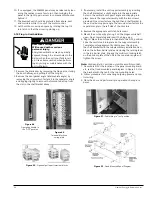
Hazardous voltage.
Will cause death or serious per-
sonal injury.
Disconnect power before working
on this equipment.
Problem
Probable Causes
Corrective Action
Blowing of motor power fuses.
Short circuit on the load side of the
Use megger and other test instruments to
motor fuses.
locate fault and correct.
Jogging or too frequent starting.
On frequent starting, fuses accumulate abnormal
heat and cool more slowly than do overload
relays. Since fuses more closely follow cooling
and heating of motor windings, successive
starting operations must be limited to the safe
capacity of the motor to prevent fuse blowing
from this cause. Check size rating on fuse
against motor full load currents and service factor.
Fuses internally damaged because of
Motor power fuses may be damaged, dropped,
improper handling.
or roughly handled. Replace with fuse of same
type, rating, and voltage.
Blowing of primary control
Shorted primary wiring in control
Replace or repair transformer.
transformer fuses.
transformer.
Fuse may be “open” due to rough
Replace with fuse of same type, rating, and voltage.
handling before installing.
Secondary fuses not properly coordinated. Melting characteristics of secondary fuse should
not intersect melting characteristic of primary
fuse. Rating of standard NEC fuse should not
exceed twice the secondary current rating.
Blowing of secondary control
Abnormal current or short circuit in
Check for shorted magnet coils, shorted rectifiers,
if supplied, grounds, loose or bent connections,
mechanical binding in relay and contractor
mechanisms, excessive operations, and incorrect
secondary terminal connections.
Siemens Energy & Automation, Inc.
40





































